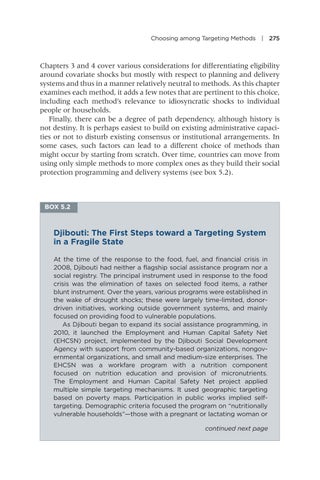Choosing among Targeting Methods | 275
Chapters 3 and 4 cover various considerations for differentiating eligibility around covariate shocks but mostly with respect to planning and delivery systems and thus in a manner relatively neutral to methods. As this chapter examines each method, it adds a few notes that are pertinent to this choice, including each method’s relevance to idiosyncratic shocks to individual people or households. Finally, there can be a degree of path dependency, although history is not destiny. It is perhaps easiest to build on existing administrative capacities or not to disturb existing consensus or institutional arrangements. In some cases, such factors can lead to a different choice of methods than might occur by starting from scratch. Over time, countries can move from using only simple methods to more complex ones as they build their social protection programming and delivery systems (see box 5.2).
BOX 5.2
Djibouti: The First Steps toward a Targeting System in a Fragile State At the time of the response to the food, fuel, and financial crisis in 2008, Djibouti had neither a flagship social assistance program nor a social registry. The principal instrument used in response to the food crisis was the elimination of taxes on selected food items, a rather blunt instrument. Over the years, various programs were established in the wake of drought shocks; these were largely time-limited, donordriven initiatives, working outside government systems, and mainly focused on providing food to vulnerable populations. As Djibouti began to expand its social assistance programming, in 2010, it launched the Employment and Human Capital Safety Net (EHCSN) project, implemented by the Djibouti Social Development Agency with support from community-based organizations, nongovernmental organizations, and small and medium-size enterprises. The EHCSN was a workfare program with a nutrition component focused on nutrition education and provision of micronutrients. The Employment and Human Capital Safety Net project applied multiple simple targeting mechanisms. It used geographic targeting based on poverty maps. Participation in public works implied self- targeting. Demographic c riteria focused the program on “nutritionally vulnerable households”—those with a pregnant or lactating woman or continued next page


